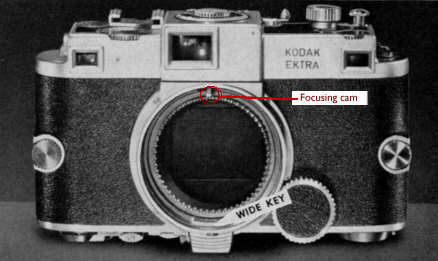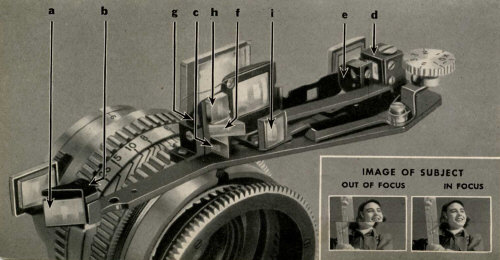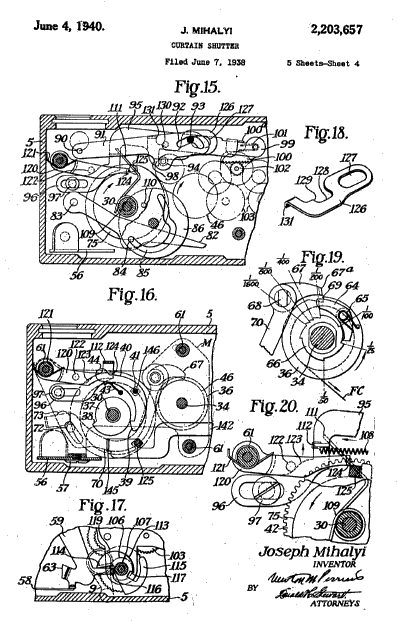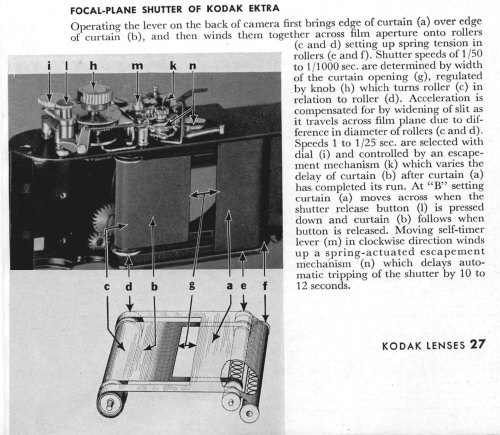Rangefinders were
one of Mihalyi's specialties and with a 104mm base, the Ektra's was designed
to accurately focus a 254mm lens. The rangefinder was of the split image
type with adjustable magnification. Although not combined with the viewfinder,
the viewing windows were closely spaced. While current 35mm users will
find many Ektra features that seem surprisingly modern in this 70+ year
old design, the viewfinder will not be one of them; it is dark and tunnel-like
when compared to modern viewfinders and even to it sister of 1941, the
Medalist, but then the Medalist had to support only one fixed-length lens.
The gear-toothed ring in the lens port allows the use of the large wheel
at the bottom of the body for fine focus adjustments or focusing can be
done with the knurled lens ring.

The later cutaway photo published
in the Kodak Reference Manual gives a more impressive internal
view than the patent drawing. Kodak's long base rangefinder design followed
a similar feature on the Contax by at least four years in patents and
nine years in production. In the cutaway image, you can also see the mechanism
for zooming the viewfinder and the wheel on the far right that controls
the diopter adjustment for the viewfinder, which was parallax-corrected
as the lens was focused. You can also see in this image that the rangefinder
used prisms, like the Contax, rather than the less-reliable mirror arrangement
used by the early Leicas.

Ektra shutters have
a notoriously bad reputation for reliability. Since I don't collect old
Leicas, Canons or Contaxes, I don't know if most cameras of this age have
similar problems. I had an Extra shutter rebuilt in the 1970s and it is
still reliable, but it has been coddled since then. As far as I know,
the Ektra was the first and last Kodak camera to have had a focal plane
shutter, but until the mid-1960s, the Ektra was the only 35mm that Kodak
had made with interchangeable lenses. From its beginning Kodak built its
consumer camera business on the low end of the market and even
when it entered the 35mm market, it did so with the fixed lens Retina
at a much lower cost point than its German competitors with interchangeable
lenses. Interchangeable lenses increased design and production costs considerably
and Kodak was very resistant to going in that direction, so its 35mm cameras
were wedded to the fix lens/between-the-lens shutter design.
Based on the patent
application considerable design work was invested in the shutter. That
the shutter was among the last mechanisms submitted for patent (June 1938)
may give some clue to problems in its design. (Complete patent record
 )
)

and Kodak was proud
to include a cutaway of the Ektra shutter in the first Kodak Reference
Manual.

Unfortunately war time
markets and the Ektra's very high price kept production low and apparently
improvements were not made, or perhaps problems only developed after long
term use. It would be interesting to know if changes in shutter design
were made to the Ektra II.
The Ektra's film back
was, I believe, a first. Leica screw mount bodies required loading film,
very inconveniently, through the bottom of the camera. Contax improved
on this with a body with a removable back, which did improve film loading
convenience and allowed the use of accessory backs for glass plates, but
the Ektra was the first camera to employ a full magazine back that could
be interchanged along with the film cassettes. It had the additional advantage
of having a rapid film advance.

|